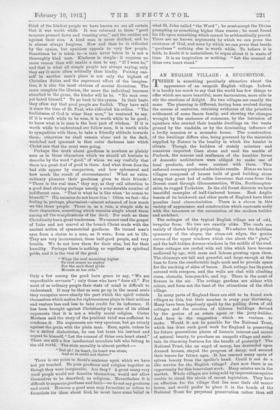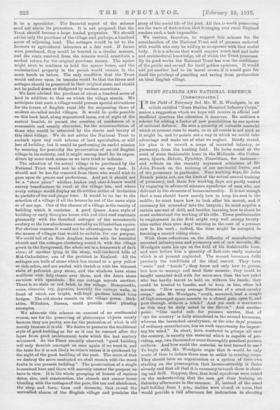AN ENGLISH VILLA.GE : A SUGGESTION. T HERE is something peculiarly
attractive about the appearance of an unspoilt English village. Indeed, it is hardly too much to say that the world has few things to offer which are more beautiful, more harmonious, more able to stir the emotions of delight. No two villages are exactly the same. The planning is different, having been evolved during the course of centuries, retaining evidences of the primitive settlement of some Saxon family, and showing the changes wrought by the enclosure of commons, by the intrusion of squatters who erected their humble dwellings on the waste ground by the roadside, or by the dominating influence of a lordly mansion or a monastic house. The °pustulation of the dwellings differs also, being governed by the materials supplied by Nature in the locality in which the hamlet is situate. Though the builders of stately minsters and mansions imported Caen stone and used the marble of Purbeck, the masons and craftsmen of the humbler forms of domestic architecture were obliged to make use of local products, and were content with them. This enforced economy produced admirable results. Hence we have villages composed of houses built of good building stone along that great bed of oolite limestone that runs from the Dorset coast through Gloucestershire, Wilts, Northampton- shire, to rugged Yorkshire. In the old forest districts we have beautiful examples of half-timbered houses. East Anglia boasts of its brickwork and other parts of England have their peculiar local characteristics. There is a charm in this variety of appearance and construction which contrasts sadly with the tameness or the ostentation of the modern builder and architect.
The cottages of the typical English village are of odd, irregular form. No two are exactly alike. The roofs are mainly of thatch boldly projecting. We admire the faultless symmetry of the slopes, the clean-cut edges, the gentle curves of the upper windows which rise about the " plate," and the half-hidden dormer-windows in the middle of the roof. Some cottages are roofed with red tiles which have become mellowed by age, with moss and lichens growing upon them. The chimneys are tall and graceful, and large enough at the base to form the comfortable ingle nook and to provide space for the smoking of sides of bacon. Each cottage has its porch covered with creepers, and the walls are clad with climbing roses, clematis, honeysuckle, and ivy. There is the scent of flowers in the air. The cottage gardens are ablaze with colour, and form not the least of the attractions of the ideal village.
In many parts of England there are still to be found such villages as this, but their number is every year decreasing. Many have been hopelessly spoilt by the pulling down of old cottages and the erection of hideous buildings devised by the genius of an estate agent or the jerry-builder. And here is the suggestion which we venture to make. Would it not be possible for the National Trust, which has done such good work for England in preserving for future generations places of historic interest and scenes of natural beauty, to purchase an unspoilt village and main- tain its charming features for the benefit of posterity ? The National Trust, like an angel of mercy, has descended upon doomed houses, stayed the progress of decay, and secured their tenure for future ages. It has rescued many spots of sylvan beauty from the spoiler's hand. Could it not do a like service for the English village ? Just now there is an opportunity for this benevolent work. Many estates are in the market. Whole villages are being sold by impecunious squires
unable to stand the strain of recent legislation. They have an affection for the village that lies near their old manor house, and would prefer to place it in the hands of the National Trust for perpetual preservation rather than sell it to a speculator. The financial aspect of the scheme need not alarm its promoters. It is not proposed that the Trust should become a large landed proprietor. We should advise only the purchase of the village and, perhaps, a hundred acres of adjoining land. The cottages would be let to the farmers or agricultural labourers at a fair rent. If farms were purchased, they would be treated in a shnilar manner, and the rents received from the tenants would constitute a modest return for the original purchase money. The squire might elect to continue to hold the manor house, and the ecclesiastical property in the parish would remain in the same hands as before. The only condition that the Trust would enforce upon its tenants would be that the farms and cottages should be preserved in their original state, and should not be pulled down or disfigured by modern accretions.
We have advised the purchase of about a hundred acres of /and in addition to that on which the village stands. We anticipate that such a village would possess special attractions for the lovers of English rural life far surpassing those of modern so-called model villages. It would be quite possible on this back land, along sequestered lanes, out of sight of the central hamlet, to permit the erection of residences of a reasonable and seemly character, for the accommodation of those who would be attracted by the charm and beauty of this ideal village. We do not advise the National Trust to embark upon any rash scheme of land speculation, or still less of building, but it would be performing its useful mission by securing for posterity the preservation of an old English village in its entirety, and it might recoup itself for its expen- diture by some such means as we have tried to indicate.
The selection of the actual village to be purchased by the National Trust would not be altogether an easy task. It should not be too far removed from those who would wish to gaze upon its graces and perfections. And yet it should not be a "show place" whither brakes and char-iabancs would convey beanfeasters to revel at the village inn, and where every cottage would display an ill-written notice of invitation to partake of tea and ginger beer. It would be no bar to the selection of a village if all the houses be not of the same style or of one age. One of the charms of a village is the variety of building which it contains. A. good Queen Anne style of building or early Georgian house with red-tiled roof contrasts pleasantly with the thatched cottages of the seventeenth century or the low almshouses erected by an Elizabethan squire. For obvious reasons it would not be advantageous to suggest the names of villages that would be suitable for our purpose. 'We could tell of an East Anglian hamlet with its beautiful church and the cottages clustering round it, with the village green in the foreground, the whole sot in a framework of dark elms ; of another lying in the steep, well-timbered hills of Mid-Oxfordshire, one of the prettiest in England. All the cottages are built of stone which has turned to a grey yellow or rich ochre, and are roofed with thatch or with the thinnest slabs of yellowish grey stone, and the windows have stone mullions with drip-stones over them, and the doors stone cornices with spandrels. No one cottage repeats another. There is no slate or red brick in the village. Honeysuckle, roses, clematis, ivy, japonica, beautify the cottage walls, in front of which are bright, well-kept gardens behind trim hedges. The old stocks remain on the village green. Berk- shire, Wiltshire, Sussex, could provide other pleasing examples.
We advocate this scheme on account of no sentimental reason, nor for the preserving of picturesque objects merely because they are pretty, nor for the protection of what is old merely because it is old. We desire to preserve the traditional style of good building as far as it can be rescued after the lapse from good architectural taste which the last century witnessed. As the Times recently observed, "good building will only flourish amongst us once again if we want it, and the taste for it is not likely to return unless it is quickened by the sight of the good building of the past. The more of that we destroy the more contented we shall remain with the worst faults in our present building." The preservation of a single homestead here and there will scarcely answer the purpose we have in view. It is the whole grouping of houses of various dates, size, and construction, the church and manor house blending with the cottages of the poor, the inn and almshouse, the shop and farm, barn and dovecote, that reveal the unrivalled charm of tho English village and proclaim the story of the social life of the past. All this is worth preserving ere the wave of destruction that is surging over rural England renders such a task impossible.
We venture, therefore, to suggest this scheine for the consideration, of the National Trust and of persons endowed with wealth who may be willing to co-operate with that useful body. It is a scheme that would require much tact and taste and architectural knowledge, all of which the Trust possesses. By its good works the National Trust has won the confidence of the public and earned for itself golden opinions. It would add yet another leaf to its laurel crown if it would gain for itself the privilege of guarding and saving from profanation an ideal English village.











































 Previous page
Previous page